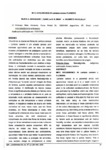Use este identificador para citar ou linkar para este item:
http://www.alice.cnptia.embrapa.br/alice/handle/doc/15910| Título: | Mite occurrence in Lantana camara flowers. |
| Autoria: | WATANABE, M. A.  MAIA, A. de H. N.   NICOLELLA, G.   |
| Afiliação: | Maria Aico Watanabe, Embrapa Meio Ambiente; Aline de Holanda Nunes Maia, Embrapa Meio Ambiente; Gilberto Nicolella, Embrapa Meio Ambiente. |
| Ano de publicação: | 2005 |
| Referência: | Ecossistema, Espírito Santo do Pinhal, v.30, n.1/2, p.29-36, 2005. |
| Conteúdo: | Lantana camara is a perennial shrub with agronomical interest as it is a weed mainly of pastures in wild state and it is a beautiful ornamental plant in its cultivated varieties/cultivars. Its flowers are pollinated by butterflies which are often seem visiting them, and by bees and hummingbirds. Cross pollination is needed in this plant for fruit and seed set, this latter being its main reproductive mechanism. On the body of these pollinators mites of the orders Mesostigmata and Astigmata live in phoresy and by hitch-hiking arrive to lantana flowers, when those pollinators visit these plants. Mite distribution in these flowers is significantly affected by factors such as temperature and air relative humidity, as mites do not having sclerotized body cover or wax covered body, are sensible to dessication at high temperature and low relative humidity. Relative frequency of mites in red flowers was nine times higher than in yellow flowers, in orange and pink flowers, this frequency was close to five times higher than in yellow flowers. This is related to the lantana flower corolla length, longer in red and pink flowers and shorter in yellow flowers. Mites consume 40 % of flower nectar volume, reducing the availability of this food to pollinators, which avoid visiting flowers which nectar was partially consumed. This reduces seed production, but also obliges the pollinators to visit different plants, promoting cross fecundation. Thus the phoretic mites have a double role in lantana reproduction, so they may be considered pests as well as beneficial organisms. The Mesostigmata being predatory on the other side has another beneficial role as pest biocontrollers. |
| Thesagro: | Ácaro Cambara |
| NAL Thesaurus: | Lantana |
| Tipo do material: | Artigo de periódico |
| Acesso: | openAccess |
| Aparece nas coleções: | Artigo em periódico indexado (CNPMA)  |
Arquivos associados a este item:
| Arquivo | Descrição | Tamanho | Formato | |
|---|---|---|---|---|
| 2007AP040.pdf | 1,79 MB | Adobe PDF |  Visualizar/Abrir |









